Carranglan
Kadanglaan | |
|---|---|
| Municipality of Carranglan | |
 Welcome arch | |
 Flag  Seal | |
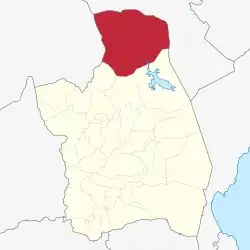 Map of Nueva Ecija with Carranglan highlighted | |
OpenStreetMap | |
.svg.png.webp) Carranglan Location within the Philippines | |
| Coordinates: 15°57′39″N 121°03′47″E / 15.9608°N 121.0631°E | |
| Country | Philippines |
| Region | Central Luzon |
| Province | Nueva Ecija |
| District | 2nd district |
| Barangays | 17 (see Barangays) |
| Government | |
| • Type | Sangguniang Bayan |
| • Mayor | Mary B. Abad |
| • Vice Mayor | Efren P. Alfonso Jr. |
| • Representative | Micaela S. Violago |
| • Municipal Council | Members |
| • Electorate | 27,485 voters (2022) |
| Area | |
| • Total | 705.31 km2 (272.32 sq mi) |
| Elevation | 305 m (1,001 ft) |
| Highest elevation | 632 m (2,073 ft) |
| Lowest elevation | 210 m (690 ft) |
| Population (2020 census)[3] | |
| • Total | 42,420 |
| • Density | 60/km2 (160/sq mi) |
| • Households | 10,440 |
| Economy | |
| • Income class | 1st municipal income class |
| • Poverty incidence | 7.68 |
| • Revenue | ₱ 254.1 million (2020) |
| • Assets | ₱ 710.4 million (2020) |
| • Expenditure | ₱ 196.8 million (2020) |
| • Liabilities | ₱ 326.2 million (2020) |
| Service provider | |
| • Electricity | Nueva Ecija 2 Area 1 Electric Cooperative (NEECO 2 A1) |
| Time zone | UTC+8 (PST) |
| ZIP code | 3123 |
| PSGC | |
| IDD : area code | +63 (0)44 |
| Native languages | Ilocano Tagalog |
Carranglan, officially the Municipality of Carranglan (Ilocano: Ili ti Carranglan; Tagalog: Bayan ng Carranglan), is a 1st class municipality in the province of Nueva Ecija, Philippines. According to the 2020 census, it has a population of 42,420 people.[3]
The municipality is home to the Pantabangan–Carranglan Watershed Forest Reserve.
History

Aerial view of Carranglan, date unknown
Geography
It is the province's largest municipality in terms of land area.
Barangays
Carranglan is politically subdivided into 17 barangays. Each barangay consists of puroks and some have sitios.
- Baluarte (now R.A. Padilla)
- Bantug
- Bunga
- Burgos
- Poblacion
- Capintalan
- Digdig (now called Joson)
- General Luna
- Minuli
- Piut
- Puncan
- Putlan
- Salazar
- San Agustin
- T. L. Padilla Pob. (Barangay I)
- F. C. Otic Pob. (Barangay II)
- D. L. Maglanoc Pob. (BarangayIII)
- G. S. Rosario Pob. (Barangay IV)
Climate
| Climate data for Carranglan, Nueva Ecija | |||||||||||||
|---|---|---|---|---|---|---|---|---|---|---|---|---|---|
| Month | Jan | Feb | Mar | Apr | May | Jun | Jul | Aug | Sep | Oct | Nov | Dec | Year |
| Mean daily maximum °C (°F) | 28 (82) |
29 (84) |
30 (86) |
32 (90) |
31 (88) |
30 (86) |
29 (84) |
28 (82) |
29 (84) |
29 (84) |
29 (84) |
28 (82) |
29 (85) |
| Mean daily minimum °C (°F) | 18 (64) |
19 (66) |
20 (68) |
22 (72) |
23 (73) |
23 (73) |
23 (73) |
23 (73) |
23 (73) |
22 (72) |
20 (68) |
19 (66) |
21 (70) |
| Average precipitation mm (inches) | 13 (0.5) |
15 (0.6) |
21 (0.8) |
33 (1.3) |
92 (3.6) |
121 (4.8) |
142 (5.6) |
124 (4.9) |
121 (4.8) |
143 (5.6) |
50 (2.0) |
22 (0.9) |
897 (35.4) |
| Average rainy days | 6.0 | 6.4 | 9.2 | 12.2 | 20.3 | 23.1 | 25.1 | 22.5 | 22.4 | 20.0 | 11.6 | 7.1 | 185.9 |
| Source: Meteoblue (Use with caution: this is modeled/calculated data, not measured locally.)[5] | |||||||||||||
Demographics
| Year | Pop. | ±% p.a. |
|---|---|---|
| 1903 | 1,468 | — |
| 1918 | 2,716 | +4.19% |
| 1939 | 6,339 | +4.12% |
| 1948 | 6,328 | −0.02% |
| 1960 | 10,100 | +3.97% |
| 1970 | 15,536 | +4.39% |
| 1975 | 16,875 | +1.67% |
| 1980 | 19,891 | +3.34% |
| 1990 | 26,064 | +2.74% |
| 1995 | 29,950 | +2.64% |
| 2000 | 31,720 | +1.24% |
| 2007 | 33,233 | +0.64% |
| 2010 | 37,124 | +4.11% |
| 2015 | 41,131 | +1.97% |
| 2020 | 42,420 | +0.61% |
| Source: Philippine Statistics Authority[6][7][8][9] | ||
Economy
Tourism
Gallery
.jpg.webp) Spanish-built bridge in Carranglan
Spanish-built bridge in Carranglan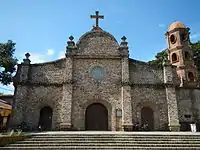 Saint Nicolas of Tolentine Parish Church
Saint Nicolas of Tolentine Parish Church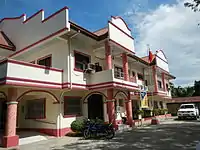 Carranglan Municipal Hall
Carranglan Municipal Hall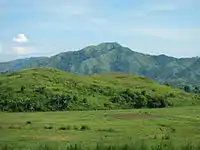 The mountains of Sierra Madre, located east of the municipality
The mountains of Sierra Madre, located east of the municipality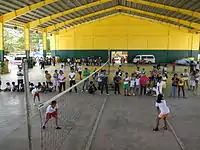 Carranglan's Gymnasium
Carranglan's Gymnasium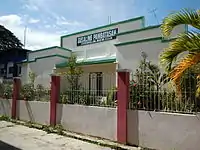 Legislative building
Legislative building Nueva Ecija University of Science and Technology - Carranglan Off-Campus
Nueva Ecija University of Science and Technology - Carranglan Off-Campus Carranglan Central School
Carranglan Central School
References
- ↑ Municipality of Carranglan | (DILG)
- ↑ "2015 Census of Population, Report No. 3 – Population, Land Area, and Population Density" (PDF). Philippine Statistics Authority. Quezon City, Philippines. August 2016. ISSN 0117-1453. Archived (PDF) from the original on May 25, 2021. Retrieved July 16, 2021.
- 1 2 Census of Population (2020). "Region III (Central Luzon)". Total Population by Province, City, Municipality and Barangay. Philippine Statistics Authority. Retrieved 8 July 2021.
- ↑ "PSA Releases the 2018 Municipal and City Level Poverty Estimates". Philippine Statistics Authority. 15 December 2021. Retrieved 22 January 2022.
- ↑ "Carranglan: Average Temperatures and Rainfall". Meteoblue. Retrieved 4 May 2020.
- ↑ Census of Population (2015). "Region III (Central Luzon)". Total Population by Province, City, Municipality and Barangay. Philippine Statistics Authority. Retrieved 20 June 2016.
- ↑ Census of Population and Housing (2010). "Region III (Central Luzon)" (PDF). Total Population by Province, City, Municipality and Barangay. National Statistics Office. Retrieved 29 June 2016.
- ↑ Censuses of Population (1903–2007). "Region III (Central Luzon)". Table 1. Population Enumerated in Various Censuses by Province/Highly Urbanized City: 1903 to 2007. National Statistics Office.
{{cite encyclopedia}}: CS1 maint: numeric names: authors list (link) - ↑ "Province of Nueva Ecija". Municipality Population Data. Local Water Utilities Administration Research Division. Retrieved 17 December 2016.
- ↑ "Poverty incidence (PI):". Philippine Statistics Authority. Retrieved December 28, 2020.
- ↑ "Estimation of Local Poverty in the Philippines" (PDF). Philippine Statistics Authority. 29 November 2005.
- ↑ "2003 City and Municipal Level Poverty Estimates" (PDF). Philippine Statistics Authority. 23 March 2009.
- ↑ "City and Municipal Level Poverty Estimates; 2006 and 2009" (PDF). Philippine Statistics Authority. 3 August 2012.
- ↑ "2012 Municipal and City Level Poverty Estimates" (PDF). Philippine Statistics Authority. 31 May 2016.
- ↑ "Municipal and City Level Small Area Poverty Estimates; 2009, 2012 and 2015". Philippine Statistics Authority. 10 July 2019.
- ↑ "PSA Releases the 2018 Municipal and City Level Poverty Estimates". Philippine Statistics Authority. 15 December 2021. Retrieved 22 January 2022.
External links
Wikimedia Commons has media related to Carranglan.
This article is issued from Wikipedia. The text is licensed under Creative Commons - Attribution - Sharealike. Additional terms may apply for the media files.
